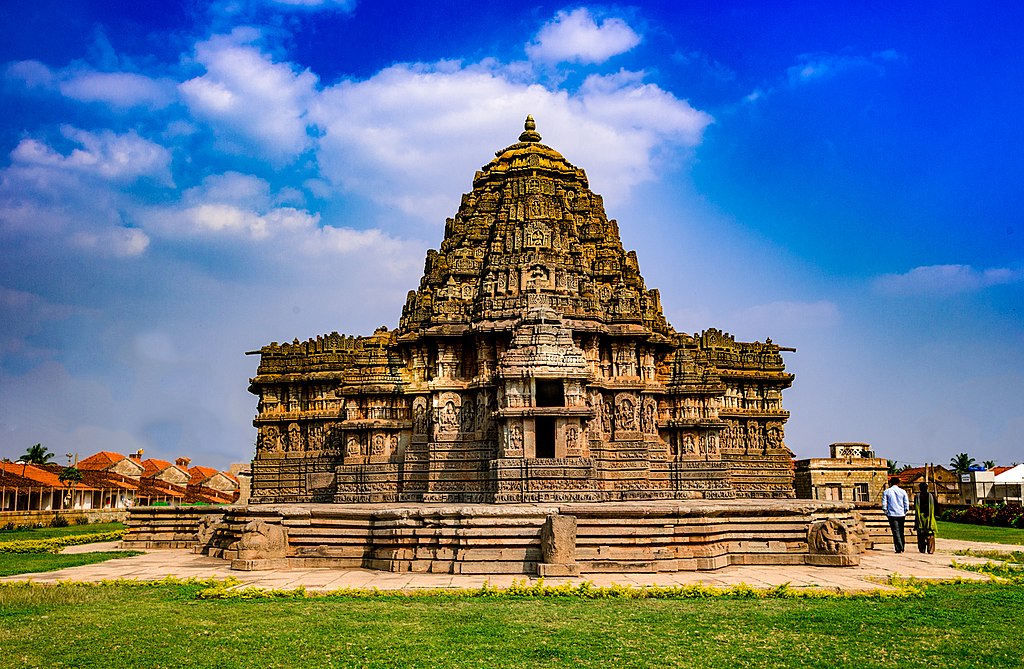Hosaholalu Lakshminarayana Temple, Karnataka

Address
Hosaholalu Lakshminarayana Temple, Hosaholalu, SH 85, Mandya district, Karnataka 571426
Diety
Lakshminarayana
Introduction
The Lakshminarayana Temple is a 13th-century temple with Hoysala architecture in Hosaholalu, Mandya district, Karnataka, India. Dedicated to Vishnu, this three-shrine monument is notable for its finely carved plinth (adhisthana) with panels of the Ramayana, the Mahabharata and the Bhagavata Purana. It has one of the most beautifully embellished Hoysala tower projections (sukanasa) that integrates the Dravida motifs with asta-bhadra Bhumija motifs from central India. Also notable are polish and jewelry-like carvings inside the temple’s mandapa.
Puranic Significance
The temple was built by King Vira Someshwara of the Hoysala Empire in 1250 C.E. It lacks a foundation inscription. The dating of the temple is based on the style of the sculptures and architecture that compares closely with the contemporary Hoysala monuments at Javagal, Nuggehalli and Somanathapura. The Vishnu temple illustrates later stage Hoysala architecture with a square plan and four-storey Vesara vimana, one that strongly resembles the Harnahalli temples. It was built using Soapstone (chloritic schist). The temple is a trikuta vimana (three shrined) temple where only the central shrine has a tower (superstructure or Shikhara) on top. The two lateral shrines merge into the ranga-mandapa towards the east. The main shrine is for Narayana, the southern shrine is dedicated to Venugopala, and the northern one to Lakshmi Narasimha. The temple is built on a jagati (platform) with decorative elephants at corners. This elevates the temple by 4.5 feet (1.4 m). It extends well beyond the temple on all sides, thus providing an integrated pradakshinapatha (circumambulation passage). The lateral shrines are square in construction with five projections and no special features. The central shrine is well decorated and its tower has a sukanasi (called “nose”) which is actually a lower tower over the vestibule that connects the shrine (containing the image of the deity) to the hall (mantapa). The sukanasi looks like an extension of the main tower over the central shrine. The six horizontal mouldings of the adhistana include intricately sculptured friezes. Seen from top to bottom; the first frieze depicts birds (hansa), the second depicts the mythical makara, the third frieze has depictions of Ramayana, Mahabharata and Bhagavata Purana legends narrated in the clockwise direction (direction of devotee circumambulation). The fourth frieze has leafy scrolls, the fifth and sixth friezes have a procession of horses and elephants respectively. In the frieze that depicts the epics, the Ramayana starts from the western corner of the southern shrine, while the Mahabharata starts from the northern side of the central shrine vividly illustrating the demise of many heroes of the famous war between Pandavas and Kauravas. The interior of the temple consists of a closed hall (mantapa) of modest size with four polished lathe turned pillars supporting the roof. The four central pillars divide the hall into nine equal “bays” (compartments) and nine decorated ceilings. The sanctum of the three shrines contain the images of Venugopala, Narayana in the middle and Lakshminarasimha; all forms (Avatar) of Vishnu.
Century/Period/Age
12th century
Managed By
Archaeological Survey of India (ASI)
Nearest Bus Station
Hosaholalu
Nearest Railway Station
Annechakanahali Station
Nearest Airport
Kempegowda International Airport Bengaluru
0









